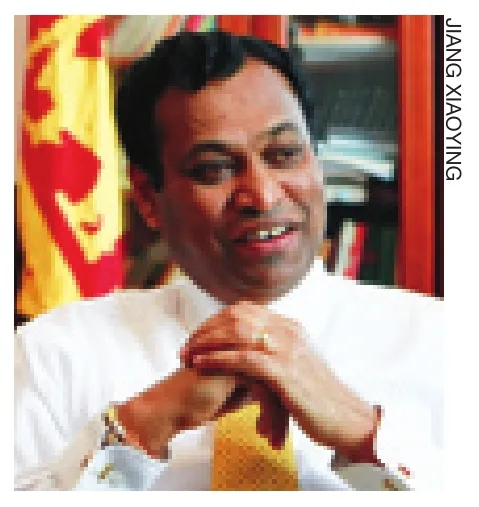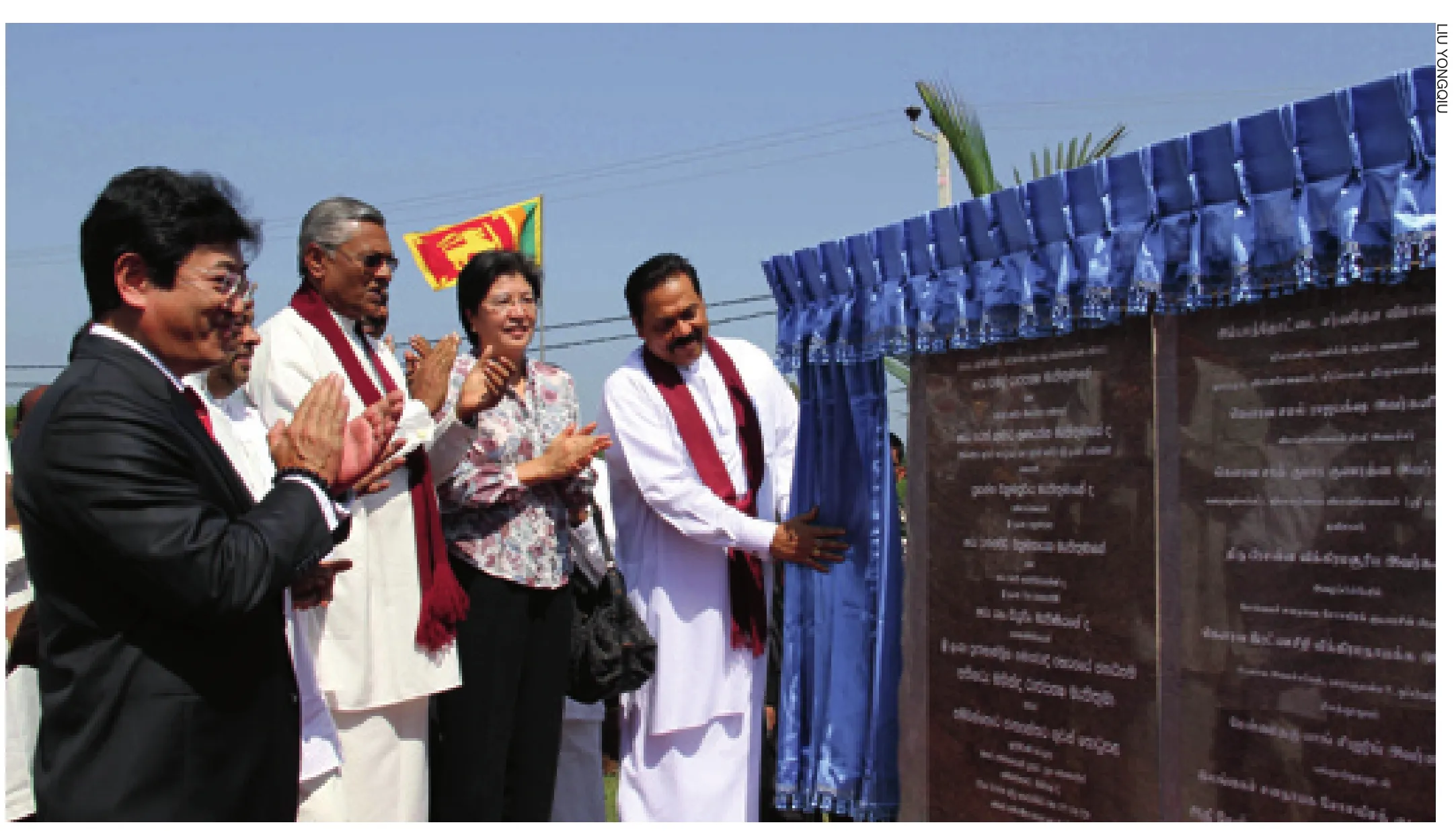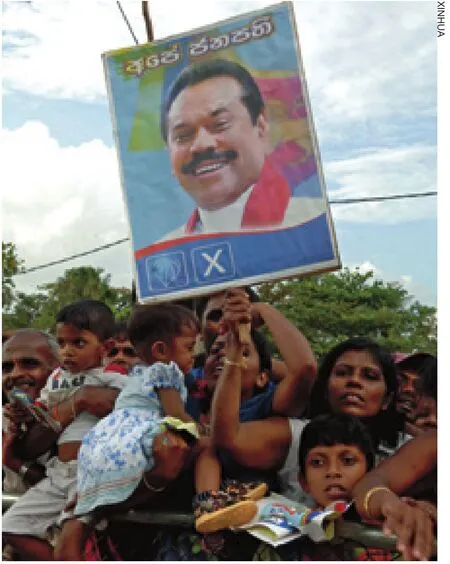A Mandate for Momentum
2010-03-15
With his re-election in January, Sri Lankan President Mahinda Rajapaksa appears poised to move his country ahead following years of civil unrest. By cashing in on its hard-won peace while strengthening ties with foreign countries—including China—he has proven himself committed to ful fi lling the island nation’s dream of becoming a “wonder of Asia.”
Beijing Review reporter Yan Wei recently spoke to Sri Lanka’s Ambassador to China Karunatilaka Amunugama about the country’s aspirations. Excerpts follow∶
Beijing Review: President Mahinda Rajapaksa set a goal of keeping its economic growth rate at 8 percent in his reelection campaign. Why is he so con fi dent,and do you think the goal is attainable?
Karunatilaka Amunugama: For decades, Sri Lanka’s economy underperformed relative to its potential due to terrorism.Despite numerous challenges, sound economic management yielded an average growth rate of 6 percent per annum over the past few years. Even in 2009, when the world fi nancial crisis took a heavy toll on the global economy, Sri Lanka’s GDP growth was 3.5 percent. It is expected to reach around 7 percent in 2010. The International Monetary Fund has also upgraded Sri Lanka to the status of a “middle-income emerging market.”

“Terrorism is now no longer an issue in Sri Lanka.”—Karunatilaka Amunugama, Sri Lanka’s Ambassador to China
Last May, we defeated the LTTE(Liberation Tigers of Tamil Eelam) terrorists. Terrorism is now no longer an issue in Sri Lanka. What we are now focusing on is infrastructure development, foreign investment and tourism. With these things, coupled with normal economic activities such as the export of tea, rubber, coconuts and industries producing garments and various computerrelated products, we can achieve at least an 8-percent annual economic growth rate in the next few years.
We have already reached the $2,000 benchmark in our per-capita income. If we continue to develop at such a rate in the next couple of years, we will de fi nitely reach an even higher per-capita income in Sri Lanka.

A SOLID TAKEOFF: Sri Lankan President Mahinda Rajapaksa (first right) unveils the nameplate of a new international airport in the southern city of Hambantota on November 27, 2009, along with China’s Ambassador to Sri Lanka Yang Xiuping (second right).That day a Chinese company formally began construction of the airport, which is scheduled to be completed in three years
Sri Lanka is a small country with a small population. But compared with many other countries, we have relatively developed infrastructure, as well as good education and healthcare systems.So Sri Lanka’s human resource development is quite remarkable. When you put these things together, you know we are able to achieve that higher growth rate.Sri Lanka has targeted an average GDP growth of 8 percent after 2010—but more importantly, it will seek to ensure that growth is more evenly spread.
Since the Sri Lankan Government defeated the separatist organization LTTE last year,Sri Lanka has been facing the pressing task of national reconciliation. What is the president’s plan in this regard?
After defeating terrorism last May, President Rajapaksa brought forward the presidential election for about two years. The reason he did this is that he felt he should seek a fresh mandate from the people to implement his new vision for the future.
In the first term, he mainly focused on bringing peace and stability to Sri Lanka. Now he wants to make the second phase of his manifesto—national reconciliation, higher growth and economic prosperity for the Sri Lankan people—a reality.
In the presidential election last December, his candidacy was approved by the people with a large margin. He received an unprecedented majority of 1.8 million votes. Now that the majority of the people in Sri Lanka have endorsed his vision, the president’s task is to achieve his economic targets during his second term and bring prosperity to the people.
To this end, he has to fi nd solutions to national issues—particularly ethnic problems. During President Rajapaksa’s first term, for example, he appointed an All-Party Representative Committee (APRC)as part of his efforts to address ethnic problems. The APRC consists of selected members from all the parties represented in the parliament. It convenes meetings to discuss how we can devolve power to help achieve the aspirations of the people. The president wants to continue discussions with all the political parties and representatives of all the ethnic groups in Sri Lanka to find ways of realizing national reconciliation and bring prosperity to the people—particularly those living in rural areas and in the war-affected areas in the north and the east.

FOR THE PEOPLE: Sri Lankans celebrate the re-election of President Mahinda Rajapaksa in Colombo on January 27
So national reconciliation and economic prosperity are at the top of President Rajapaksa’s agenda in his second term.The people will support him. We are going for the general election on April 8. We are expecting a large majority of the people to support the president’s political party so that it will have strong parliamentary support in implementing the president’s vision.
What’s your view on the relationship between our two countries?
Sri Lanka is one of the first countries to recognize the People’s Republic of China(PRC) after it was established in 1949. We recognized the PRC in January 1950 and,seven years later, the two countries established formal diplomatic relations. Since then, we have enjoyed strong political, economic and cultural relations.
Since President Rajapaksa came to power a few years ago, he has made special efforts to build a closer relationship with China’s political leaders. I’m proud to say that within the last three years, the president has visited China no less than three times and had bilateral meetings with President Hu Jintao and his team on three occasions. Our Prime Minister Ratnasiri Wickramanayaka has visited China two times. All these are evidence that we have a concrete foundation for our political friendship.
Economically, we have also forged a strong partnership between our two countries. At the moment,bilateral trade totals $1.7 billion.Although the trade balance is in favor of China, we are not complaining because we can develop some other areas of our trade relations. For example, Chinese development assistance to Sri Lanka has increased considerably. In the last three years,China has provided Sri Lanka with about $3.5 billion worth of development assistance in the field of infrastructure development. We are building harbors, ports, airports and roads with China’s support. China has also assisted Sri Lanka with the construction of public buildings. A lot of Chinese investment has fl owed into Sri Lanka in recent years.
Culturally, we have frequent exchanges of artistic and religious groups. Tourism is one of the most promising areas we are working on.With peace in Sri Lanka, we had a 20-percent increase in Chinese travelers to Sri Lanka in the second half of last year. We are planning to introduce additional fl ights to Beijing and open Sri Lankan Airlines flights to Shanghai.With more flights, we are confident that we can attract a higher flow of tourist traf fi c to Sri Lanka.
Sri Lanka currently holds the chair of South Asian Association for Regional Cooperation (SAARC). What’s your take on the prospects of South Asian cooperation within the SAARC framework?
SAARC brings brotherhood, friendship and partnership among South Asian nations. Some people have argued that SAARC has not developed as much as we expected. But if you look at other regional organizations such as the EU and ASEAN(Association of Southeast Asian Nations),you will come to realize that the development of regional organizations always takes a lot of time. It calls for efforts to build better understanding between neighbors—not only political understanding but also people-to-people exchanges. Strong economic relations between member countries are also essential. It is therefore a gradual process.
Sri Lanka has good relations with all the South Asian countries. At the SAARC summit last year, we discussed issues ranging from food security to antiterrorism. I believe SAARC has a bright future. And we are working to develop more consensus and closer relations in different fi elds so that SAARC will help create a more prosperous South Asia. ■
